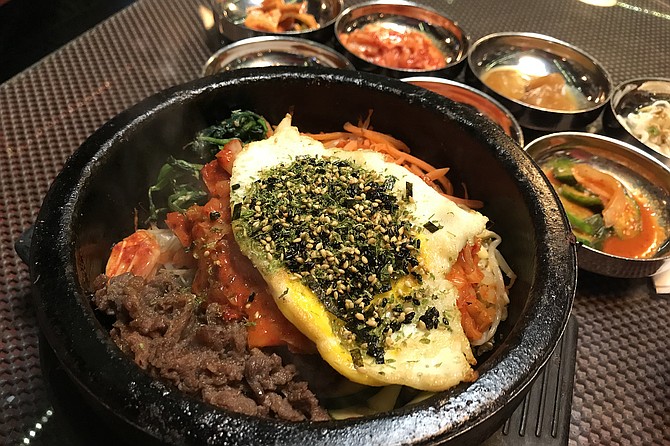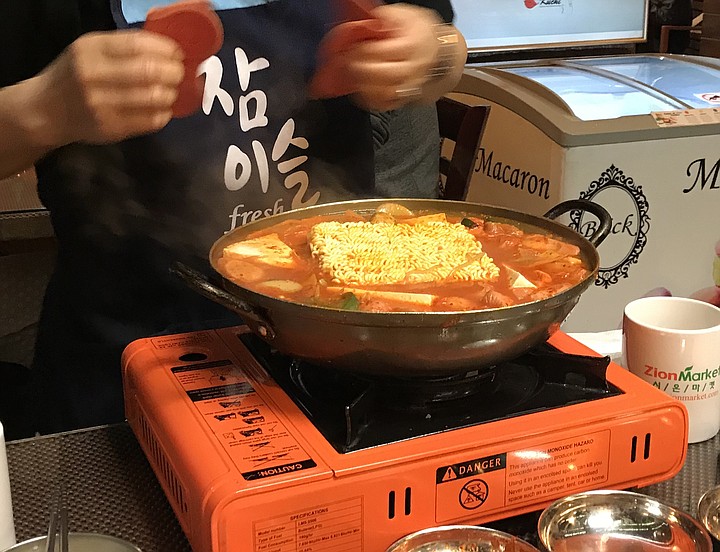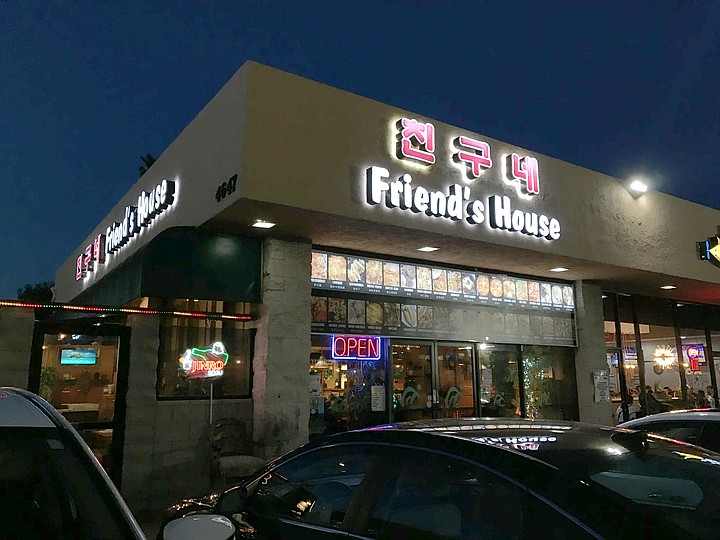 Facebook
Facebook
 X
X
 Instagram
Instagram
 TikTok
TikTok
 Youtube
Youtube

Aaargh! Second time I’ve tried. This time it’s even worse. I look at the screen beside the “sign in” sign. “Parties waiting: 68. Estimated wait time 03:27.”
That’s 3 hours and 27 minutes?
No way, güey. Except, way. This is outside Kura, the Japanese “revolving” sushi bar on Convoy. Meaning dishes revolve around you on a conveyer belt and you just pick what you want as it floats by.

But three hours’ wait? That’s why I’m heading into Little Korea. I need to eat, like, now. Come across this modest-looking place called “Friend’s House.”
Inside’s woody. Ply dividers, low timber struts, sloping roof, and attractive paper and wood screens. They also have an outside patio with firepits warming it up.
You sit mostly at rows of tables, so it’s pretty tight, but that’s okay. Conversation starter. Except talk all around seems to be in Korean. Except the couple to my left, who I swear are talking in Chinese.
And man oh man. All these names of dishes. I don’t recognize nothin’. Dwaeji Dupbap? Ddeokbokki? Jjinmandu? Haemul Pajeon? Soondae? Ohjinguh Jjigae? Ayee!
Though once I tell myself to stop panicking, when you actually look a little closer, you can see that jjigae has to mean “soup.” Because every “soup” dish ends with jjigae. Okay, not every one. Mahndu Guk turns out to be dumplings soup with eggs and veggies and noodles (costs $10.99). Dduk Guk is a rice cake soup, same sides, also $10.99. (All dishes are $1 cheaper at lunchtime.)

Then you see that dishes ending in bap are about rice. Rice plates cost between $11 and $16. And oh yeah. They do have translations. Haemul Bokkeumbap is seafood fried rice. Goes for $11.99 right now. Includes veggies and a side salad.
Kimchi’s everywhere too. It’s the one item everyone recognizes as Korean. And now a lot of people are calling it the healthiest food in the world, because it’s like yogurt. (They ferment the veggies with probiotic lactic-acid bacteria. Don’t ask what that means. From here, you’re on your own). Whatever, kimchi is fermented veggies, specially cabbage, plus spices and seasonings, and it has a vinegar thing going. Started as a way to preserve food through long cold winters.
So yeah, by now I’m breaking the menu down to rice dishes, soups, noodle dishes, seafood, and hot pots. I start off ordering a Korean beer. “Hite,” I say to the Korean lady zapping about. It’s $7.99 for a large bottle. She nods. “And the hot sake,” I say on impulse. I mean, I know I’m overspending. But it’s only $5.99. Will make a great combo.
Couple next door, Lutong and Xueshi, turn out to be computer science students at UCSD. They’re from Beijing, and come eat here for a change from the campus cafeteria. “Korean food is most like our Szechuan cuisine,” says Lutong. “It can be hot. But it’s drier, less oily than Chinese dishes.”
What they’re ordering is interesting. Boodae jungol. “It means ‘Army Base Stew,’” says the server lady. Huh. Goes back to when the US Army had even more troops in South Korea than they do today. Boodae has American processed meats like hot dogs, bacon, ham, and hey, Spam, all tossed in. Shades of Hawaii.
The other famous Korean dish, burlgogi, Korean marinated beef, costs $16.99. Short ribs, $20.99. Combos start at $24.99 and go up to $40.99.
But Lutong and Xueshi (her name means “Erudition”) stick with Army Base Stew. Cook brings a mini grill and sticks it on the table between them. Then, another cook tops it with a steaming, stainless steel casserole filled to the brim with hot orange liquids and floating meats, plus kimchi, and tofu, and vermicelli. Man. Now the server dunks a square of ramen noodles into the liquid, and extra slices of Spam. It’s massive! Costs them $29.99. Plus $3 for the ramen. But what a feast.

Me, I land on #17. It’s a rice bowl mixed with veggies and beef and egg, all in a black stone bowl that stays hot forever. I like the hotstone idea. Cost, $11.99. Oh, and an extra buck for stir-fried kimchi, so $12.99.
First, of course, the other Korean thing: we all get served half a dozen shallow bowls of appetizers. Free! I get fish cake, kimchi, potatoes in a gravy, pickled beansprouts, chunks of mung bean jelly, fine-sliced radishes in a hot sauce, and cucumbers, also swimming in some vinegary juices. Nice touch.
But now my hotstone comes, radiating heat, hissing steam. Marinated beef, spinach, carrot strings, lots of other veggies, a slash of red kimchi, and a big fried egg (or is it two?) sitting on top, supporting an island of seaweed and sesame seeds.
“You have to mix it all up before you eat,” says the server. Heck. Don’t want to spoil the picture, but I know it’s a Korean thing, so I take my stainless chopsticks and start turning the bowl into a mess. I add, well, hot sauce. Not the Korean one you’d expect, gochujang, but standard Sriracha.
It still makes a vinegary, meaty, eggy, collision of flavors that I’m loving. And everything stays hot till the end, thanks to this great, heat-retaining bowl. The meat’s definitely sweet. Contrasts with the kimchi’s sauerkraut taste, though not really that sour. Bonus: the rice below gets more and more savory as the liquids drip on it.
And the Hite Korean beer — Budweiser by another name, I swear, but it works fine here — is a nice, between-chomp pleasure. Specially chasing the hot sake.
I head out totally stuffed. I guess Mission Not Accomplished, as far as revolving restaurants. But as I stand waiting for the #44 bus, I check out the Reader online. Turns out Barbarella went to Kura back in 2015, when it was apparently called “Kula.” Hope she didn’t have to wait 3-1/2 hours.


Aaargh! Second time I’ve tried. This time it’s even worse. I look at the screen beside the “sign in” sign. “Parties waiting: 68. Estimated wait time 03:27.”
That’s 3 hours and 27 minutes?
No way, güey. Except, way. This is outside Kura, the Japanese “revolving” sushi bar on Convoy. Meaning dishes revolve around you on a conveyer belt and you just pick what you want as it floats by.

But three hours’ wait? That’s why I’m heading into Little Korea. I need to eat, like, now. Come across this modest-looking place called “Friend’s House.”
Inside’s woody. Ply dividers, low timber struts, sloping roof, and attractive paper and wood screens. They also have an outside patio with firepits warming it up.
You sit mostly at rows of tables, so it’s pretty tight, but that’s okay. Conversation starter. Except talk all around seems to be in Korean. Except the couple to my left, who I swear are talking in Chinese.
And man oh man. All these names of dishes. I don’t recognize nothin’. Dwaeji Dupbap? Ddeokbokki? Jjinmandu? Haemul Pajeon? Soondae? Ohjinguh Jjigae? Ayee!
Though once I tell myself to stop panicking, when you actually look a little closer, you can see that jjigae has to mean “soup.” Because every “soup” dish ends with jjigae. Okay, not every one. Mahndu Guk turns out to be dumplings soup with eggs and veggies and noodles (costs $10.99). Dduk Guk is a rice cake soup, same sides, also $10.99. (All dishes are $1 cheaper at lunchtime.)

Then you see that dishes ending in bap are about rice. Rice plates cost between $11 and $16. And oh yeah. They do have translations. Haemul Bokkeumbap is seafood fried rice. Goes for $11.99 right now. Includes veggies and a side salad.
Kimchi’s everywhere too. It’s the one item everyone recognizes as Korean. And now a lot of people are calling it the healthiest food in the world, because it’s like yogurt. (They ferment the veggies with probiotic lactic-acid bacteria. Don’t ask what that means. From here, you’re on your own). Whatever, kimchi is fermented veggies, specially cabbage, plus spices and seasonings, and it has a vinegar thing going. Started as a way to preserve food through long cold winters.
So yeah, by now I’m breaking the menu down to rice dishes, soups, noodle dishes, seafood, and hot pots. I start off ordering a Korean beer. “Hite,” I say to the Korean lady zapping about. It’s $7.99 for a large bottle. She nods. “And the hot sake,” I say on impulse. I mean, I know I’m overspending. But it’s only $5.99. Will make a great combo.
Couple next door, Lutong and Xueshi, turn out to be computer science students at UCSD. They’re from Beijing, and come eat here for a change from the campus cafeteria. “Korean food is most like our Szechuan cuisine,” says Lutong. “It can be hot. But it’s drier, less oily than Chinese dishes.”
What they’re ordering is interesting. Boodae jungol. “It means ‘Army Base Stew,’” says the server lady. Huh. Goes back to when the US Army had even more troops in South Korea than they do today. Boodae has American processed meats like hot dogs, bacon, ham, and hey, Spam, all tossed in. Shades of Hawaii.
The other famous Korean dish, burlgogi, Korean marinated beef, costs $16.99. Short ribs, $20.99. Combos start at $24.99 and go up to $40.99.
But Lutong and Xueshi (her name means “Erudition”) stick with Army Base Stew. Cook brings a mini grill and sticks it on the table between them. Then, another cook tops it with a steaming, stainless steel casserole filled to the brim with hot orange liquids and floating meats, plus kimchi, and tofu, and vermicelli. Man. Now the server dunks a square of ramen noodles into the liquid, and extra slices of Spam. It’s massive! Costs them $29.99. Plus $3 for the ramen. But what a feast.

Me, I land on #17. It’s a rice bowl mixed with veggies and beef and egg, all in a black stone bowl that stays hot forever. I like the hotstone idea. Cost, $11.99. Oh, and an extra buck for stir-fried kimchi, so $12.99.
First, of course, the other Korean thing: we all get served half a dozen shallow bowls of appetizers. Free! I get fish cake, kimchi, potatoes in a gravy, pickled beansprouts, chunks of mung bean jelly, fine-sliced radishes in a hot sauce, and cucumbers, also swimming in some vinegary juices. Nice touch.
But now my hotstone comes, radiating heat, hissing steam. Marinated beef, spinach, carrot strings, lots of other veggies, a slash of red kimchi, and a big fried egg (or is it two?) sitting on top, supporting an island of seaweed and sesame seeds.
“You have to mix it all up before you eat,” says the server. Heck. Don’t want to spoil the picture, but I know it’s a Korean thing, so I take my stainless chopsticks and start turning the bowl into a mess. I add, well, hot sauce. Not the Korean one you’d expect, gochujang, but standard Sriracha.
It still makes a vinegary, meaty, eggy, collision of flavors that I’m loving. And everything stays hot till the end, thanks to this great, heat-retaining bowl. The meat’s definitely sweet. Contrasts with the kimchi’s sauerkraut taste, though not really that sour. Bonus: the rice below gets more and more savory as the liquids drip on it.
And the Hite Korean beer — Budweiser by another name, I swear, but it works fine here — is a nice, between-chomp pleasure. Specially chasing the hot sake.
I head out totally stuffed. I guess Mission Not Accomplished, as far as revolving restaurants. But as I stand waiting for the #44 bus, I check out the Reader online. Turns out Barbarella went to Kura back in 2015, when it was apparently called “Kula.” Hope she didn’t have to wait 3-1/2 hours.
Comments